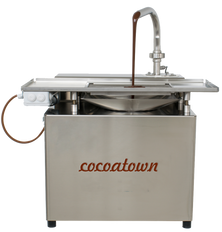Melanger
By Andal Balu
One of the most common confusion customers have is: What is the difference between a Wet Grinder (also called an Indian Spice Grinder), and a Melanger? Both feature stone on stone grinding to grind spices, grains, and (of course!) cocoa beans into a smooth paste. At a glance, a Melanger (or the larger Grindeurs) may look very similar to a Wet Grinder, but in practice they are quite different.
While not yet ubiquitous in the U.S., Wet Grinders are a staple of Indian kitchens. They’re used for grinding grains, lentils, and spices into batter for idlis, dosas, and chutneys. These types of ingredients take about 15-20 minutes of grinding per batch (two batches at a time), and the grinders themselves are typically used 3-4 times per week. Indian markets (especially in the South) are flooded with low-cost, often low-quality Wet Grinders.
Melangers, on the other hand, are built for situations that require longevity, both with individual tasks and overall lifespan. They are used to grind nuts into nut butters or nut milks, sesame seeds into tahini, and—most importantlycocoa beans into chocolate.
While most Wet Grinder foods can reach their optimal textures in a few minutes, Melangers were developed with runtimes of 2-3 days in mind. In order to get silky, smooth cocoa liquor (the precursor to delicious chocolate), it must be ground down to a particle size of about 15-18 microns, which takes time! A simple Wet Grinder is not built for that kind of job.
In many ways, the difference comes down to the quality of the components. Because there is such a big market for Wet Grinders, there is a great deal of competition based on lower prices and outer appearance. Manufacturers may cut corners in construction for a flashier look. They generally use aluminum coils in the motors, which tend to fail in the long run, and are not as heavily monitored for safety because they are used in brief bursts, under constant supervision. Wet Grinder makers also tend to use low-grade stainless steel for the drums and assembly pieces, as well as low-cost, low-density granite.
For Wet Grinders, this all adds up to a lower-quality product, much more subject to failure or even disaster, in the form of a short or electrical fire! Over time, the motors wear out, the low-grade steel drums can flex and lose their shape, the food-contact portions may not be up to national standards of some countries, and the low-quality granite can flake and crumble, potentially contaminating the food you’re making.
CocoaTown Melangers use heavy-duty copper wiring, high grade stainless steel construction, and dense, long-lasting granite. We make them to be run continuously, and to hold up over years of productivity. Some of our machines have been in constant use for over a decade, and show minimal signs of wear. On top of the exemplary quality, we have built additional safety features to all our machines. There is an automatic shut-off switch in case the motor begins overdrawing current (for example, if the stones become stuck due to over-viscous cocoa liquor while the motor is still trying to turn the drum). If that fails and the motor starts to overheat, there is a second, temperature-based shut-off.
And as an international business, CocoaTown builds to the highest possible standards, so that our Melangers can easily be sold around the world. We are constantly working with customers both to keep up with local regulations, but also to improve the quality and versatility of our products. We provide accessories to allow for more functionality, or to work in large-scale commercial use.
In short, the return on investment for a CocoaTown Melanger far exceeds that of a common Wet Grinder. Frequent maintenance and short lifespans mean that, over time, you’ll pay much more for a series of lower-quality wet-grinders than if you purchase one of our units that will last a lifetime!

